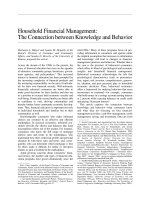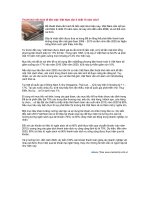Tài liệu Dangerous Unintended Consequences: How Banking Bailouts, Buyouts and Nationalization Can Only Prolong America’s Second Great Depression and Weaken Any Subsequent Recovery docx
Bạn đang xem bản rút gọn của tài liệu. Xem và tải ngay bản đầy đủ của tài liệu tại đây (679.35 KB, 94 trang )
DangerousUnintendedConsequences:
HowBankingBailouts,BuyoutsandNationalization
CanOnlyProlongAmerica’sSecondGreatDepression
andWeakenAnySubsequentRecovery
Presentedby
MartinD.Weiss,Ph.D.
WeissResearch,Inc.
NationalPressClub
Washington,DC
March19,2009
2
Copyright © 2009 by Weiss Research
15430 Endeavour Drive
Jupiter, FL 33478
Media Contacts
JoyHowell
Phone:202.828.7838
Email:
ElizabethKelleyGrace
Phone:561.989.9855
Email:
PamReimer(Broadcast)
Phone:608.727.2600
Email:
MartinD.Weiss,Ph.D.,presidentofWeissResearch,Inc.,isoneofthenation’sleadingadvocatesforinvestorsand
savers,helpinghundredsofthousandsfindsafetyevenintheworstoftimes.Issuingwarningsoffuturefailures
without
ambiguityandwithmonthsofadvanceleadtime,WeisspredictedthedemiseofBearStearns102dayspriortoits
failure,LehmanBrothers(182daysprior),FannieMae(eightyearsprior),andCitigroup(110daysprior).Similarly,
theU.S.Go
vernmentAccountabilityOffice(GAO)reportedthat,inthe1990s,WeissgreatlyoutperformedMoody’s,
Standard&Poor’s,A.M.BestandD&P(nowFitch)inwarningoffutureinsurancecompanyfailures.Dr.Weissholdsa
Ph.D.fromColumbiaUniversity,andhastestifiedmanytimesbeforeCongress,providingconstructiveproposalsfor
reforminthefinancialindustry.
WeissResearch,Inc.isanindependentinvestmentresearchfirmfoundedin1971,providinginformationandtoolsto
helpinvestorsandsaversmakesoundfinancialdecisionsthroughitsfreedailye‐letter,Moneyan
dMarkets,itsmonthly
SafeMoneyReport,andotherinvestorpublications.
AlthoughTheStreet.comhasprovideddataandratingsusedinthisreport,theopinionsandanalysisexpressedhereare
strictlythoseofMartinD.WeissandWeissResearch,Inc.
Thefollowingindividualsalsocontributedtothispaper:
MikeLarson,InterestRateandRealEstateAnalyst,WeissResearch,Inc.
PhilipW.vanDoorn,SeniorBankingAnalyst,TheStreet.comRatings
Mathieu‐LouisAoun,FinancialResearchAnalyst, WeissResearch,Inc
AmberDakar,PersonalFinanceAnalyst,WeissResearch,Inc
3
DangerousUnintendedConsequences:
HowBankingBailouts,BuyoutsandNationalization
CanOnlyProlongAmerica’sSecondGreatDepression
andWeakenAnySubsequentRecovery
MartinD.Weiss,Ph.D.
ExecutiveSummary
TheFedChairman,theTreasurySecretary,andCongresshavenowdonemoretobailoutfinancialinstitutions
andpumpupfinancialmarketsthananyoftheircounterpartsinhistory.
Butit’snotnearlyenough;and,atthesametime,it’salreadyfartoomuch.
Twoyearsago,whenmajorbanksannouncedmultibillionlossesinsubprimemortgages,theworld’scentral
banksinjectedunprecedentedamountsofcashintothefinancialmarkets.Butthatwasnotenough.
Sixmonthslater,whenLehmanBrothersandAmericanInsuranceGroup(AIG)fell,theU.S.Congressrushedto
passtheTroubledAssetReliefProgram,thegreatestbankbailoutlegislationofalltime.Butasitturnedout,
thatwasn’tsufficienteither.
Subsequently,inadditiontotheoriginalgoalofTARP,theU.S.governmenthasloaned,invested,or
committed$400billiontonationalizetheworld’stwolargestmortgagecompanies,$42billionfortheBig
Threeautomanufacturers;$29billionforBearStearns,$185billionforAIG;$350billionforCitigroup;$300
billionfortheFederalHousingAdministrationRescueBill;$87billiontopaybackJPMorganChaseforbad
LehmanBrotherstrades;$200billioninloanstobanksundertheFederalReserve’sTermAuctionFacility
(TAF);$50billiontosupportshort‐termcorporateIOUsheldbymoneymarketmutualfunds;$500billionto
rescuevariouscreditmarkets;$620billionincurrencyswapsforindustrialnations,$120billioninswapsfor
emergingmarkets;trillionstocovertheFDIC’snew,expandedbankdepositinsuranceplustrillionsmorefor
othersweepingguarantees;anditstillwasn’tenough.
Ifithadbeenenough,theFedwouldnothavefeltcompelledyesterdaytoannounceitsplantobuy$300
billioninlong‐termTreasurybonds,anadditional$750billioninagencymortgagebackedsecurities,plus$100
billionmoreinGSEdebt.
Totaltallyofgovernmentfundscommittedtodate:Closinginon$13trillion,or$1.15trillionmorethanthe
tallyjust24hoursago,whenthebodyofthiswhitepaperwasprinted.Andyet,eventhatastronomicalsumis
stillnotenoughforanumberofreasons:
First,mostofthemoneyisbeingpouredintoavirtuallybottomlesspit.EvenwhileUncleSamspendsorlends
hundredsofbillions,thewealthdestructiontakingplaceatthehouseholdlevelinAmericaisoccurringinthe
trillions—$12.9trillionvaporizedinrealestate,stocks,andotherassetssincetheonsetofthecrisis,
accordingtotheFed’slatestFlowofFunds.
Second,mostofthemoneyfromthegovernmentisstillapro
mise,andevenmuchofthedisbursedfunds
haveyettoreachtheirdestination.Meanwhile,allofthewealthlosthasalreadyhithome—inthehousehold.
4
Third,thegovernmenthasbeen,andis,greatlyunderestimatingthemagnitudeofthisdebtcrisis.Specifically,
TheFDIC’s“ProblemList”oftroubledbanksincludesonly252institutionswithassetsof$159billion.
However,basedonouranalysis,atotalof1,568banksandthriftsareatriskoffailurewithassetsof
$2.32trillionduetoweakcapital,assetquality,earningsandotherfactors.(ThedetailsareinPartIof
ourpaper,andtheinstitutionsarenamedinAppendixA.)
WhenTreasuryofficialsfirstplannedtoprovideTARPfundstoCitigroup,theyassumeditwasamongthe
stronginstitutions;thatthefundswouldgoprimarilytowardstabilizingthemarketsortheeconomy.But
evenbeforethecheckcouldbecut,theylearnedthatthemoneywouldhavetobeforaverydifferent
purpose:anemergencyinjectionofcapitaltopreventCitigroup’scollapse.Basedonouranalysis,however,
Citigroupisnotalone.WecouldwitnessasimilaroutcomeforJPMorganChaseandothermajorbanks.
(SeePartII.)
AIGisbig,butit,too,isnotalone.Yes,inaFebruary26memorandum,AIGmade thecasethatits
$2trillionincreditdefault swaps (CDS)wouldhavebeen thebi g eventthatcouldhavecausedaglobal
collapse.Andindeed,itscounterpartiesalonehave$36trillioninassets.ButAIG’sCDSportfolioisjust
oneofmany:Citibank’sportfolioha s $2.9trillion,almostatrillionmorethanAIG’satitspea k .JPMorgan
Chasehas$9.2trillion,or almostfivetimesmorethanAIG.Andgloba lly ,theBankofInternational
Settlements(BIS)reportsatotalof $57.3trillionincreditdefault swaps,morethan28timeslargerthan
AIG’sCDSportfolio.
Clearly,themoneyavailabletotheU.S.governmentistoosmallforacrisisofthesedimensions.Butatthe
sametime,themassivesumsbeingcommittedbytheU.S.governmentarealsotoomuch:IntheU.S.banking
industry,shotgunmergers,buyoutsandbailoutsareaccomplishinglittlemorethanshiftingtheirtoxicassets
likeDDTupthefoodchain.Andthegovernment’spromisestobuyupthetoxicpaperhavedonelittlemore
thanencouragebankstoholdon,pilingupevenbiggerlosses.
Themoneyspentorcommittedbythegovernmentsofarisalsotoomuchforanother,less‐knownreason:
Hiddeninanobscurecornerofthederivativesmarketisauniquecreditdefaultswapthatvirtuallynooneis
talkingabout—contractsonthedefaultoftheUnitedStatesTreasurybonds.Quietlyandwithoutfanfare,a
smallbutgrowingnumberofinvestorsarenotonlythinkingtheunthinkable,they’reactuallyspendingmoney
onit,biddingupthepremiumsonTreasurybondcreditdefaultswapsto14timestheir2007level.Thisisan
earl
ywarningofthenextbigshoetodropinthedebtcrisis—seriouspotentialdamagetothecredit,
credibilityandborrowingpoweroftheUnitedStatesTreasury.
Wehavenodoubtthat,whenpressed,theU.S.governmentwilltakewhateverfuturestepsarenecessaryto
sufficientlycontrolitsfinancesandavoidafataldefaultonitsdebts.However,neithertheadministrationnor
anyothergovernmentcancontroltheperceptionsofitscreditorsinthemarketplace.Andcurrently,the
market’sperceptionoftheU.S.government’screditisfalling,asanticipationofapossiblefuturedefaultby
theU.S.government,nomatterhowunlikely,isrising.
Thistrendpacksapowerfulmessage—thatthere’snofreelunch;thatit’sunreasonabletobelievetheU.S.
governmentcanbailouteveryfailinggiantwithnoconsequences;andthat,contrarytopopularbelief,even
UncleSammustfacehisdayofreckoningwithcreditors.
5
Weviewthatasapositiveforce.Weareoptimisticthat,thankstothepowerofinvestors,creditors,andthe
peopleoftheUnitedStates,wewillultimatelyguide,nudgeandpushourselvestomakeprudentand
courageouschoices:
1.Wewillbackofffromthetacticaldebatesabouthowtobailoutinstitutionsormarkets,andrethinkour
overarchinggoals.Untilnow,theoft‐statedgoalhasbeentopreventanationalbankingcrisisandavoidan
economicdepression.However,wewillsoonrealizethatthetruecostsofthatenterprise—the13‐digitdollar
figuresanddamagetoournation’scredit—arefartoohigh.
2.Wewillreplacetheirrational,unachievablegoalofjury‐riggingtheeconomiccycle,withthereasoned,
achievablegoalofrebuildingtheeconomy’sfoundationinpreparationforaneventualrecovery.
Rightnow,thepublicknowsintuitivelythatakeyfactorthatgotusintotroublewastoomuchdebt.Yet,
thesolutionbeingofferedistoencouragebankstolendmoreandpeopletoborrowmore.
Economistsalmostuniversallyagreethatoneofthegraveweaknessesofoureconomyisthelackof
savingsneededforhealthycapitalformation,investmentinbettertechnology,infrastructure,and
education.Yet,thesolutionbeingofferedistospendmoreand,byextension,tosaveless.
Thesedisconnectswillnotpersist.Policymakerswillsoonrealizetheyhavetochangecourse.
3.Whenwechangeourgoals,itnaturallyfollowsthatwewillalsochangeourpriorities—fromthebattleswe
can’twintothewarwecan’taffordtolose:Rightnow,forexample,despiteobviouslychoppyseas,the
prevailingtheoryseemstobethattheshipisunsinkable,orthatthegovernmentcankeepitafloatnomatter
howbadthestormmaybe.
Withthattheory,theymightask:“Whyhavelifeboatsforeverypassenger?Whydomuchmoreforhospitals
thatarelayingoffERstaff,forcountlesscharitiesthataregoingbroke,orforonein50Americanchildrenwho
arehomeless?WhyprepareforthefinancialKatrinasthatcouldstrikenearlyeverycity?”
Theanswerwillbe:Becausewehavenootherchoice;becausethat’sawarwecanandwillwin.Itwillnotbe
veryexpensive.Wehavetheinfrastructure.Andwe’llhaveplentyofvolunteers.
4.Rightnow,ourlong‐termstrategiesandshort‐termtacticsareinconflict.Wetrytosquelcheachcrisisand
kickitdowntheroad.Thenwedoitagainwitheachnewcrisis.Meanwhile,fiscalreformsaretalkedupin
debatesbutpushedoutintime.Regulatorychangesaremappedoutindetail,butunderminedinpractice.
Soon,however,withmorereasona
ble,achievablegoals,theoryandpracticewillfallintosynch.
5.Insteadoftryingtoplugourfingersinthedike,we’regoingtoguideandmanagethenaturalflowofa
deflationcycletoreapitssilver‐liningbenefits—areductioninburdensomedebts,astrongerdollar,alower
costofliving,ahealthierworkethic,anenhancedabilitytocompeteglobally.
6.We’regoingtobufferthepopulationfromthemostharmfulsocialside‐effectsofaworst‐casescenario.
Thenwe’regoingtostepup,bitethebullet,paythepenaltyforourpastmistakes,andmakehardsacrifices
todaythatbuildafirmfoundationforaneventualeconomicrecovery.Wewillnotdemandinstant
gratification.Wewillassumeresponsibilityforthefutureofourchildren.
6
7.Wewillceasethedoubletalkandreturntosomebasicaxioms,namelythat:
Thepriceistheprice.Onceitisestablishedthatouroverarchinggoalistomanage—notblock—natural
economiccycles,itwillnaturallyfollowthatregulatorscanguide,ratherthanhinder,amarket‐driven
cleansingofbaddebts.Themarketpricewillnotfrightenus.Wecanuseitmoreuniversally tovalueassets.
Alossisaloss.Whetherinstitutionsholdassetorsellassets,whethertheydecidetosellnoworselllater,
iftheassetisworthlessthanwhatitwaspurchasedfor,it’saloss.
Capitaliscapital.Itisnotgoodwill,orotherintangibleassetsthatareunlikelytoeverbesold.Itisnottax
advantagesthatmayneverbereaped.
Afailureisafailure.Ifmarketpricesmeanthatinstitutionshavebiglosses,andifthebiglossesmeanall
capitalisgone,thentheinstitutionhasfailed.
8.Wewillpro‐activelyshutdowntheweakestinstitutionsnomatterhowlargetheymaybe;provide
opportunitiesforborderlineinstitutionstorehabilitatethemselvesunderaslimdietoflow‐risklending;and
givethesurviving,well‐capitalizedinstitutionsbetteropportunitiestogainmarketshare.
KansasCityFederalReservePresidentThomasHoenigrecommendsthat“publicauthoritieswouldbedirected
todeclareanyfinancialinstitutioninsolventwheneveritscapitallevelfallstoolowtosupportitsongoing
operationsandtheclaimsagainstit,orwheneverthemarketlosesconfidenceinthefirmandrefusesto
providefundingandcapital.Thisdirectiveshouldbeclearlystatedandconsistentlyadheredtoforallfinancial
institutionsthatarepartoftheintermediationprocessorpaymentssystem.”Weagree.
9.Wewillbuildconfidenceinthebankingsystem,butinaverydifferentway:Rightnow,bankingauthorities
aretheirownworstenemy.Theypainttheentirebankingindustrywithasinglebroadbrush—“safe.”But
whenconsumersseebigbanksonthebrinkofbankruptcy,theirresponseistopainttheentireindustrywith
analternatebroadbrush—thattheentirebankingindustryis“unsafe.”Topreventthatoutcome,wewill
challengetheauthoritiestoreleasetheirconfidentialCAMELSratingsoneachbankinthecountry.Andto
restoresomeriskfordepositors,wewillaskthemtoreversetheexpansionofFDICcoveragelimits,bringing
backthe$100,000capfo
rindividualsandbusinesses.
Althoughthesestepsmayhurtindividualbanksintheshortrun,itwillnotharmthebankingsysteminthe
longrun.Quitethecontrary,whenconsumershaveareasontodiscriminaterationallybetweensafeand
unsafeinstitutions,andwhentheyhaveamotivetoshifttheirfundsfreelytostrongerhands,theywill
strengthenthebankingsystem.
IammakingtheserecommendationsbecauseIamoptimisticwecangetthroughthiscrisis.Oursocialand
physicalinfrastructure,ourknowledgebase,andourDemocraticformofgovernmentarestrongenoughto
makeitpossible.Asanation,we’vebeenthroughworsebefore,andwesurvivedthen.Withallourwealth
andknowledge,wecancertainlydoitagaintoday.
Butmyoptimismcomeswithnoguarantees.Ultimately,we’regoingtohavetomakeachoice:Theright
choiceistomakesharedsacrifices,letdeflationdoitswo
rk,andstartregeneratingtheeconomicforcesthat
havemadetheUnitedStatessuchagreatcountry.Thewrongchoiceistotaketheeasywayout,trytosave
7
mostbigcorporations,printmoneywithoutbounds,debaseourdollar,andultimatelyallowinflationto
destroyoursociety.
Thiswhitepaperismysmallwayofencouragingyou,withdataandreason,tomaketherightchoicestarting
rightnow.
8
Introduction
Withinfewerthan18months,theU.S.governmenthasspent,loaned,guaranteedorcommittedan
astronomicalsumof$11.6trillioninanall‐outattempttobailoutfailingcompanies,saveWallStreetfroma
financialmeltdown,andpreventaneconomicdisaster.Yet,despitetheseHerculeanefforts,American
householdshavelost$12.9trillioninwealth,millionsarelosingtheirjobs,andtheeconomyissi
nkingintoa
depression.
Thebailoutsarenotworking.Andsixmonthsago,inourwhitepaper,“Proposed$700BillionBailoutIsToo
Little,TooLatetoEndtheDebtCrisis;TooMuch,TooSoonfortheU.S.BondMarket,”weexplainedwhy.
Wearguedthat
1. The$700billionrequestedbytheBushadministrationundertheTroubledAssetReliefProgram(TARP)
torescuethenation’sbanksandotherfinancialinstitutionswouldbevastlyinadequatetocoverthe
probablelossesinAmerica’svastcreditmarkets.
2. TheburdenofsuchmassiverescueswouldmakeitincreasinglyexpensiveanddifficultfortheU.S.
governmenttosellitsbonds.
1
Today,inthehalf‐yearthathaselapsedsinceourpaper’spublication,anabundanceofnewevidencemakesit
plainlyevidentthatourfirstargumentwas,ifanything,understated.Meanwhile,strongerevidencevalidating
oursecondargument—regardingpotentialU.S.governmentfundingdifficulties—isjustbeginningtocome
tolight.Inthispaper,weprovideupdatedandexpandedresearchonbothissues:
Weestimatethedimensionsofthedebtcrisis,includingthenumberofU.S.banksandthriftswebelievetobe
atriskoffailure,atotaltallyoftheirassets,andthenamesofeach.
WeexplainthethreattotheTreasurybondmarkets,showinghowdifficultitcouldbecomefortheU.S.
governmenttorefunditsmaturingdebts—letalonefinanceitsbulgingdeficits.
Andweprovidenewrecommendationsforavertingaworst‐casescenario.Bankfailuresandadepressionare
nottheendoftheworld.Providedthecrisisismanagedproperly,itsmostdamagingimpactscanbeavoided
andlong‐termbenefitswillaccru
e.
1
Inour2008paper(availableat />theanalysisofTheStreet.comratingswithourownevaluationofderivativesandotherrisksoflargeinstitutionswhichwefeelare
notadequatelycapturedbytheTheStreet.comratingsmodel.Inthispaper,forthesakeofbetterclarity,weprovideTheStreet.com
listbasedontheCallReportdataandaseparate,shorter,listbasedonWeissResear
ch’sanalysisofderivativesandotherrisks.
9
PartI
TheFDICGreatlyUnderstatestheNumberand
AssetsofU.S.BanksCurrentlyatRiskofFailure
Financialfailurecanappearinmanyforms.Sometimesthecompanyfilesforbankruptcyvoluntarily;
sometimesit’sboughtout,bailedoutorsimplyliquidated.Nomatterwhatthefinaloutcome,forthe
purposesofthispaper,weconsideritafailure.
Toflagpotentialfailuresinthebankingsystem,theFederalDepositorsInsuranceCorporation(FDIC)maintains
a“ProblemList”ofbanks,oftenusedbythepublicandpolicymakerstogagetheseverityofthebankingcrisis.
Andinitsmostrecentrelease,
2
theFDICreportedthat
ItsProblemListgrewduringthefourthquarterfrom171to252institutions,thelargestnumbersincethe
middleof1995.
ThetotalassetsofinstitutionsontheProblemListincreasedfrom$115.6billionto$159billion.
Comparedtoayearearlier,thenumberofinstitutionsonthelistrose232percent,whiletheirtotalassets
surgedbyasurprisinglysharp623percent.
TheFDICdoesnotdisclosethenamesoftheinstitutionsonitsProblemList.However,thereisabundant
evidencethatitunderstatestheriskofbankfailuresintheU.S.byawidemargin,asfollows:
First,itwaswidelyreportedthatoneofthelargestbankstofailin2008,IndyMacBankofPasadena,California,
withassetsof$32billion,wasnotontheFDIC’sProblemList,evidencethatthelistisnotcapturingthe
broaderthreatstotheU.S.bankingsystem.
Second,severallargeinstitutions,eachofwhichhasassetsmanytimeslargerthanthe$159billiontallyofthe
FDIC’sProblemList,weretroubledenoughtoreceivelargeemergencyinjectionsofTARPfunds.Therefore,it’s
obviousthattheyarealsonotontheFDIC’slist.
Third,astatisticalratingsmodelconceptuallysimilartothoseusedbyfederalregulatorsforidentifyinghigh‐
riskbanksgeneratesalistofinstitutionsatriskoffailurewhichwebelieveismorecomprehensiveand
accuratethantheProblemListmaintainedbytheFDIC.
ABriefHistoryofSomeStatisticalRatingsModelsforBanksandThrifts
Theba
nkingregulators havedeve lopedamethodologyforflaggingtroubledbanks,curr entl ycalledCAMELSrat ings,
whichev alua tecapitaladequacy,ass etquality,manag ement,earnings,liquidity,and sensitiv itytomark etrisk .
Theresultsofthismodelarenotpublished.However,inthe1980s,whentheofficialCallReportdatabecame
morereadilyavailabletothepublic,independentresearchfirms,suchasVeribancofMassachusettsandT.J.
HoltandCo.ofConnecticut,developedratingsmethodologiesthatwerebasedconceptually(albeitnot
2
QuarterlyBankingProfile,FourthQuarter2008,availableat />
10
mathematically)ontheFed’sCAMELSratings.Subsequently,actuarialstudiesperformedonboththeT.J.Holt
andVeribancratingsdemonstratedaconsistentpatternwhereby
virtuallyallinstitutionsthatsubsequentlyfailedhadreceivedalowratingmonthsearlier;
few,ifany,institutionswithahighratingfailedwithinayea
raftertheratingswerepublished.
Althoughnotalllow‐ratedinstitutionssubsequentlyfailed,thefailurerateoflow‐ratedinstitutionswasvery
high,validatingourviewthattheyareatriskoffailure,especiallyinadeeprecessionordepression.
In1987,WeissResearchpurchasedtheHoltbankratingsdatabaseandquantitativemodels,incorporating
elem
entsofitsownqualitativebankratingsmethodologyandpublishingtheseunderthebannerofWeiss
SafetyRatings.
Inits1994study,InsuranceRatings:ComparisonofPrivateAgencyRatingsforLife/HealthInsurers,
3
theU.S.
GeneralAccountabilityOffice(GAO)reviewedtheWeissratingsscale(fromAtoF)anddeterminedthata
WeissSafetyRatingofD+orlowerdenotesinstitutionsthatare“vulnerable”tofuturefinancialfailures.
Further,thehighpercentageofcompaniesratedD+orlowerthatsubsequentlyfailedagainvalidatedthe
generalaccuracyofthatdesignation.AlthoughtheGAOwasreferringtoadifferentindustry(lifeandhealth
insurers),theWeissratingsscalewasdesignedtoconveythesamesignificanceacrossvariousfinancial
industries,includingcommercialbanks,savingsbanks,andsavingsandloanassociations.
In2006,theNewYorkmediafirmTheStreet.compurchasedtheWeissRatings,nowcalledFinancialStrength
Ratings.However,TheStreet.comratingsscale(AthroughF)isthesameastheearlierWeissratingsscale,
whiletheratingsmethodologyhasremainedvirtuallythesameaswell.
Now,forthepurposesofthispaper,TheStreet.comhasprovidedalistofallrateddepositoryinstitutionswith
aFinancialStrengthRatingofD+(weak)orlower.
4
Andbasedonthebackgroundcitedabove,webelievethe
listisbothmorecomprehensiveandmoreaccuratethantheFDIC’s.
5
Fromthelist,WeissResearchfindsthat:
1,372commercialandsavingsbanksareatriskoffailurewithtotalassetsof$1.79trillion(AppendixA).
196savingsandloanassociationsareatriskwith$528billioninassets(AppendixB).
Insum,atotalof1,568banksandthriftsareatriskwithassetsof$2.32trillion.That’s6timesthenumber
orinstitutionsand15timestheassetsofbanksandthriftsontheFDIC’sfourthquarter2008ProblemList.
Giventhedeteriorationinbanksandintheeconomyreportedbythe FDICandtheCommerceDepartment,
itislikelythatmorebanksandthriftswillbeaddedtothelistoncefourthquarterratingsbecomeavailable.
3
AvailableinpdfimageformatprovidedbytheGAOat />4
TheStreet.com’sdatasourcesaretheFederalFinancialInstitutionsExaminationCouncilCallReportandtheOfficeofThrift
Supervision’sThriftFinancialReportsforthethirdquarterof2008,asprovidedbyHighlineFinancial,Inc.,withreferencetothe
fourthquarterCallReportsstrictlytodeterminewhichbankswerestillinbusinessaty
earend.
5
TheopinionsexpressedhereregardingTheStreet.comratingsareexclusivelythoseofMartinWeissandWeissResearch.
11
TheprecisedifferencesbetweentheFDIC’smethodforflaggingproblembanksandthemethodusedhereare
notknown.However,theaggregateresultsshouldmakeitclearthatthemagnitudeofthebankingtroublesin
theU.S.todaycouldbefargreaterthanwhattheFDICispubliclyrecognizing.
12
PartII
U.S.CommercialBanksHaveTakenMassive,
OftenUnquantifiable,RisksinTheirDerivativesHoldings
Thecollapseofmajorfinancialinstitutionssince2008hascomeasashocktobothWallStreetand
Washington.Butnearly15yearsago,theU.S.GovernmentAccountabilityOffice(GAO)explicitlywarnedof
thispossibility.OnMay18,1994,inalandmarkstudy,FinancialDerivatives,ActionsNeededtoProtectthe
FinancialSystem,
6
itstatedthat:
1. Derivativestradinginvolvesexposuretofivedifferentrisks:
(a)creditrisk,definedas“thepossibilityoflossresultingfromacounterparty'sfailuretomeetitsfinancial
obligations”;
(b)marketrisk,“adversemovementsinthepriceofafinancialassetorcommodity”;
(c)legalrisk,“anactionbyacourtorbyaregulatoryorlegislativebodythatcouldinvalidateafinancial
contract”;
(d)operationsrisk,“inadequatecontrols,deficientprocedures,humanerror,systemfailure,orfraud”;and
(e)systemrisk,achainreactionoffinancialfailuresthatcouldthreatenthenationalorglobalbanking
system.
2. Over‐the‐counter(OTC)derivativestradingataffiliatesofsecuritiesandinsurancecompaniesare
unregulatedandgrowingtoorapidly.
3. Justfivemajorsecuritiesfirms,threeinsurancecompaniesandsevencommercialbanksaccountforthe
overwhelmingbulkofthederivativestrading.
4. “IfoneoftheselargeOTCdealersfailed,thefailu
recouldposeriskstootherfirms—includingfederally
insureddepositoryinstitutions—andthefinancialsystemasawhole.”
5. “Financiallinkagesamongfirmsandmarketscouldheightenthisrisk.Derivativesclearlyhaveexpanded
thefinanciallinkagesamongtheinstitutionsthatusethemandthemarketsinwhichtheytrade.Various
studiesoftheOctober1987marketcrashshowedlinkagesbetweenmarketsforequitiesandtheir
derivatives.Accordingtothosestudies,pricesinthestock,options,andfuturesmarketswererelated,so
thatdisruptionsinonewereassociatedwithdisruptionsintheothers.”
6. “TheconcentrationofOTCderivativesactivitiesamongarelativelyfewdealerscouldalsoheightentherisk
ofliquidityproblemsintheOTCderivativesmarkets,whichinturncouldposeriskstothefinancialsystem.
BecausethesamerelativelyfewmajorOTCderivativesdealersnowaccountforalargeportionoftrading
inanumberofmarkets,theabruptfailureorwit
hdrawalfromtradingofoneofthesedealerscould
6
Availableat />
13
underminestabilityinseveralmarketssimultaneously,whichcouldleadtoachainofmarketwithdrawals,
possiblefirmfailures,andasystemiccrisis.”(Italicsareours.)
7. “ThefederalgovernmentwouldnotnecessarilyintervenejusttokeepamajorOTCderivativesdealerfrom
failing,buttoavertacrisis,theFederalReservemayberequiredtoserveaslenderoflastresorttoany
majorU.S.OTCderivativesdealer,whetherregulatedorunregulated.”
InresponsetotheGAO’s1994warningsabove,thefinancialindustry’sresponsewasbothaudibleandcaustic.
MajorWallStreetfirmspushedbackwithconcertedlobbyingeffortstoblockanyregulatorychangesatthe
pass,while“ChickenLittle”accusationswereleveledattheauthors,Congressionalrequestersofthestudy,
andanyindependentfirm,suchasWeissResearch,thatmadeforecastsbasedonitsconclusions.
7
Theindustry’sprimaryargumentindefenseofderivativeswasthattheyhelpedtoreduceriskthrough
hedging,andthateachderivativespositionwasgenerallybalancedagainstoffsettingpositions.However,
manylargefinancialinstitutions—suchasBearStearns,LehmanBrothers,MerrillLynchandtheAmerican
InsuranceGroup(AIG)—wentfarbeyondhedging,transformingtheirderivativesdivisionsintomajorprofit
centersbasedonspeculativetrading.Moreover,theydidnotadequatelyprotectthemselvesagainstdefaults
bytheirtradingpartnersoranticipatetheseverityofthesystemriskstressedbytheGAO.
Subsequently,asdetailedintheGAO’sfollow‐upreport,FinancialDerivatives:ActionsTakenorProposed
SinceMay1994,
8
some,mostlycosmetic,changesweremade.Buttheydidnothingtoslowthemeteoric
growthoftheveryinstrumentsandpracticesthattheGAOidentifiedasposingthegreatestthreatsto
financialinstitutionsandthefinancialsystem.Specifically,
Inits1994study,theGAOreported,“Thebestavailabledataindicatethatthetotalvolumeofworldwide
derivativesoutstandingasofyear‐end1992wasatleast$12.1trillionintermsofthenotional,orprincipal,
amountofderivativescontracts.”AlthoughtheGAOrecognizedthatthe$12.1trillionoverstatedthe
actualrisk,italsostatedthat“firmsthatusederivativescansustainsignificantlosses,”implyingthat$12.1
trillionwasalreadyconsideredadangerouslylargenumber.
However,thatnumberpalesincomparisontothelatesttallyofnoti
onalOTCderivativesbytheBankof
InternationalSettlements(BIS).
9
Atmid‐year2008,theBISreported$683.7trillion,or56.5timesthelevel
reportedbytheGAOfor1992.
Worse,amongthesewere$57.3trillionincreditdefaultswaps,orbetsonthefailureofnamed
corporations.Thesecontractsarewidelyrecognizedasthehighestriskcategoryofderivativesandare
directlyresponsibleforth
edemiseofAIG,oneofthelargestthreatstotheglobalfinancialsystemtoday.
7
InSafeMoneyReport,Issue#294,October2,1998,wewrote“EvenastheDowmakesnewhighs,WallStreetandtheworld’s
financialmarketssitatopagiganticmountainofderivatives—high‐riskbetsanddebtsthattotalamind‐boggling$285trillion.”
/>.Similarly,inSafeMoneyReport,Issue#391,November2006,we
wrote“It’saglobalVesuviusthatcoulderuptatalmostanytime,instantlythrowingtheworld’sfinancialmarketsintoturmoil
bankruptingmajorbanks sinkingbignameinsurancecompanies scramblingtheinvestmentsofhedgefunds overturningthe
portfoliosofm
illionsofaverageinvestors,” />.
8
/>9
/>
14
Atthetimeofthe1994GAOstudy,creditdefaultswapsbarelyexisted;nowtheyarenearlyfivetimes
largerthanthetotaltallyofglobalderivativesinallcategoriesreportedbytheGAOfor1992.
Inits1994study,theGAOwarnedofextremeconcentrationinthederivativesmarket,withthetopseven
domesticbankderivativesdealersaccountingformorethan90percentofallU.S.bankderivativesactivity
asofDecember1992.
Today,thedatareportedbytheComptrolleroftheCurrency(OCC)demonstratesthatnotonlyhasthere
beenafailuretobetterdiversifyderivativestradingacrossabroaderrangeofplayers,theconcentration
hasactuallyincreased.AsofSeptember30,2008,insteadofsevenmajorplayersamongU.S.commercial
banks,therewereonlyfive.Andinsteadofcontrolling90percent,thesefivebankscontrolled97percent
ofthetotalindustrynotionalamount.
10
Moreover,theOCCalsoreportsthat,ofthe$175.8trillioninnotionalderivativesheldbyU.S.commercial
banksatSeptember30,2008,onesingleplayer,JPMorganChaseBankNA,controls$87.7trillion,or49.9%,
raisingseriousquestionsregardingitsvirtualmonopolyintheU.S.derivativesmarketandthesystemicrisk
impliedbyanyfailure.
11
(Seeaccompanyingtable.)
Rank BankName State
Total
Assets
Total
Derivatives
Total
Futures
(EXCHTR)
Total
Options
(EXCHTR)
Total
Forwards
(OTC)
TotalSwaps
(OTC)
TotalOptions
(OTC)
TotalCredit
Derivatives
(OTC) SpotFX
1 JPMORGANCHASEBANKNA OH
$1,768,65 $87,688,008 $1,442,086 $2,349,629 $8,949,110 $54,385,247 $11,384,205 $9,177,731 $218,733
2 BANKOFAMERICANA NC
1,359,071 38,673,967 1,622,080 643,185 3,651,347 26,796,894 3,479,789 2,480,672 237,758
3 CITIBANKNATLASSN NV
1,207,007 35,645,429 253,586 432,226 5,071,607 20,210,646 6,737,581 2,939,783 536,543
4 WACHOVIABANKNATLASSN NC
664,223 4,221,834 223,423 87,961 211,515 2,913,470 464,389 321,076 15,248
5 HSBCBANKUSANATLASSN DE
181,587 4,133,712 85,293 113,974 565,779 1,938,203 277,515 1,152,948 76,457
6 WELLSFARGOBANKNA SD
514,853 1,429,088 174,358 21,694 468,891 562,659 199,766 1,720 19,149
7 BANKOFNEWYORKMELLON NY
218,699 1,193,652 28,549 58,355 383,966 384,724 336,641 1,417 56,668
8 STATESTREETBANK&TRUSTCO MA
276,291 869,294 2,054 713 786,206 17,927 57,249 5,145 54,802
9 SUNTRUSTBANK GA
170,007 276,689 63,232 26,671 14,275 137,461 31,987 3,063 407
10 PNCBANKNATLASSN PA
134,780 198,478 26,441 12,500 6,079 124,859 23,660 4,940 1,580
11 NORTHERNTRUSTCO IL
68,930 175,128 0 0 165,238 9,232 389 269 22,761
12 KEYBANKNATLASSN OH
97,811 136,302 20,652 4,400 15,325 79,430 8,805 7,690 1,277
13 NATIONALCITYBANK OH
141,501 123,530 16,007 350 12,326 49,853 42,700 2,293 123
14 U.S.BANKNATLASSN OH
242,597 97,056 1,640 9,000 23,871 51,272 9,618 1,655 878
15 MERRILLLYNCHBANKUSA UT
61,643 94,255 72,285 246 614 12,086 0 9,025 0
16 REGIONSBANK AL
139,556 80,094 13,964 3,500 1,222 59,482 1,487 439 7
17 BRANCHBANKINGANDTRUSTCO NC
133,166 71,044 3,599 0 8,632 49,228 9,533 52 57
18 RBSCITIZENSNATLASSN RI
132,609 59,474 0 0 4,890 53,129 1,228 228 37
19 FIFTHTHIRDBANK OH
67,318 58,101 94 0 8,999 39,367 9,333 308 863
20 LASALLEBANKNATLASSN IL
63,388 33,701 0 0 0 24,414 7,398 1,890 0
21 UNIONBANKOFCALIFORNIANA CA
62,431 33,557 2,361 0 4,371 18,303 8,522 0 1,059
22 UBSBANKUSA UT
26,176 33,317 0 0 0 33,317 0 0 0
23 DEUTSCHEBANKTRCO NY
43,932 27,004 0 0 391 20,941 601 5,071 0
24 MORGANSTANLEYBANKNA UT
37,638 25,941 0 0 0 2,156 0 23,785 0
25 FIRSTTENNESSEEBANKNA TN
32,587 24,546 287 0 10,870 11,200 2,189 0 2
T
op
2
5
Co
mm
e
r
c
i
a
lB
a
nk
s
&
T
Cs
Wi
t
hD
e
riv
at
iv
es
$
7
,8
4
6,
4
6
$
17
5,
4
03,
2
0
2
$
4
,05
1
,99
1
$3,
7
6
4
,
4
0
4
$
2
0,365,5
24
$
1
0
7
,985,
4
98
$
2
3,09
4
,585
$
1
6,
141
,
2
00
$
1
,
244
,
4
08
OtherCommercialBanks&TCsWithDerivatives 2,703,969 438,563 6,816 2,869 58,678 290,590 72,421 7,188 1,523
TotalCommercialBanks&TCsWithDerivatives 10,550,43 175,841,765 4,058,807 3,767,273 20,424,203 108,276,088 23,167,006 16,148,388 1,245,931
Source:OCC
Inits1994study,theGAOalsoreported“asimilarconcentrationofactivityamongU.S.securities
derivativesdealers.Thetopfivebynotional/contractamountsaccountedforabout87percentoftotal
derivativesactivityforallU.S.securitiesfirmsasoftheirfiscalyear‐end1992.”
10
OCC’sQuarterlyReportonBankTradingandDerivativesActivitiesThirdQuarter2008,
/>11
Ibid.,Table1,pdfpage22.
15
Today,mostofthemajorU.S.securitiesderivativesdealershavefailed,beenboughtout,orbailedoutby
thefederalgovernment.
Inits1994study,theGAOstressedthat“creditriskisakeyconsiderationinmanagingOTCderivatives,”
butpointedoutthat“managingcreditriskcanbedifficultforOTCderivativesbecausecreditexposurecan
changerapidly.”
Today,theOCCdatademonstratethatthecreditriskisbeyondexcessive:FouroutoffiveofthemajorU.S.
commercialbankderivativesplayershavetotalcreditexposurethatexceedstheirrisk‐basedcapital.
(Moreonthissubjectbelow.)
Thus,despit
ethemodestreformsdiscussedintheGAO’s1996follow‐upreport,thedangersassociatedwith
derivatives—theiracceleratedpaceofgrowthandmultiplelevelsofrisk—onlychangedfortheworse.
MeanwhiletheGAO’swarningsaboutthepossibledisastersresultingfromaderivatives‐relatedfailurewere
prescient:
1. AstheGAOclea
rlyimpliedinitsreport,therapidgrowthofunregulatedOTCderivativesnowposesa
seriousthreattotheglobalfinancialsystem.
2. AstheGAOwarned,theconcentrationoftradingamongasmallnumberoflargeplayershaspinnedthe
futureofthefinancialsystemonahandfulofhigh‐rollers.
3. AstheGAOwarned,eachofthefiverisksitcited—creditrisk,marketrisk,legalrisk,operationsriskand
systemrisk—havecometogetherinasingleexplosivemixnowthreateningstability.
4. AstheGAOwarned,thefailureofonelargeOTCderivativesdealerhasposedriskstoothermajorfirms,
includingfederallyinsureddepositoryinstitutionsandthefinancialsystemasawhole.Itsname:Lehman
Brothers.Moreover,asexplainedbelow,thenearfailureofalargerfirm,AmericanInsuranceGroup(AIG),
posesevengreaterthreats.
5. AstheGAOwarned,thefinanciallinkagesamongfirmshaveheightenedthisrisk.Moreover,asit
explainedwithitsreferencetothe1987stockmarketcrash,theselinkageshavebecomeespeciallycritical
inthewakeofrecentmarketcrashes—inboththeU.S.housingmarketandglobalstockmarkets.
6. AstheGAOwarned,theabruptfailureorwithdrawalfromtradingofoneofthelargedealershas
underminedthestabilityofseveralmarketssimultaneously,leadingtoachainofmarketwithdrawals,firm
failuresandsystemiccrisis:We’veseensimultaneousande
xtremeinstability inthemarketsformortgages,
interbankloans,assetbackedsecurities(ABS),commercialpaper,corporatebondsandevenmoney
marketfunds.
7. Finally,astheGAOalsowarned,theFederalReservehasbeenrequiredtoserveasalenderoflastresort
tomajorU.S.OTCderivativesdealers,whetherregulatedorunregulated:TheFedhasjumpedintoextend
massiveloansnotonlytocommercialbanksunderitsjurisdictionbutalsotobroker‐dealers,insurersand
others.
16
MajorFinancialInstitutionsatRiskofFailure
Duetothecontinuingscarcityofdetaileddataonthemultipleriskfactorsassociatedwithderivatives,itis
difficulttopinpointpreciselywhichlargeinstitutionsareatgreatestrisk.However,theOCChasdevelopeda
measureofthetotalcreditexposureofmajorderivativesplayers,asfollows:
MajorU.S.Ba nksOverexposedtoDefau ltRisk
(CreditExposurewithDerivativesasa%ofRisk‐BasedCapital)
664.2
400.2
259.5
177.6
85.2
0 100 200 300 400 500 600 700
HSBC Bank USA
JPMorgan Chase
Citibank
Bank of America
Wachovia
Data: OCC
Thischartanswersthequestion:Foreachdollarofcapital,howmuchexposuredoeseachbankhavetothe
possibledefaultsofitsderivativestradingpartners?Anditshowsthatamongcommercialbanks,allbutoneof
thefivelargestplayersareexposedtothetuneofover100percentoftheircapital,analarminglevelevenin
theabsenceofafinancialcrisisordepression.
BelowisamoredetailedanalysisofthetwolargestofthefivebankscoveredbytheOCCreport—Citibank
andJPMorganChase—alongwithasummaryreviewoftheremainingthree.
CitibankNA(NV)isthenation’sthirdlargestcommercialbank,with$1.2trillionintotalassets.Despiteits
largesize,how
ever,WeissResearchplacedCitibankonitslistofbanksatriskinAugustof2008.Belowisan
updatedsummaryofouranalysisthatformedthebasisofthisdecision.
1. Citibankhasaveryhighcreditexposurerepresenting259.5percentofitsrisk‐basedcapital,asin
dicatedin
thechartabove.
2. Itholds$2.94trillionincreditderivatives,almostentirelycomposedofcreditdefaultswaps,
12
knowntobe
themostdangerouscategoryofderivatives.
12
TheOCCreportsthat,basedonindustry‐widefigures,99percentofcreditderivativesarecreditdefaultswaps.
17
3. AnditreceivesaborderlineFinancialStrengthRatingofC‐(fair)dueprimarilytonetlossesfromprovisions
forloanlossesandtradinglossesandadeclineinthequalityofitsassets.
Inaddition,Citigroup’sDecember31,200810‐Kreport
13
showsthat
4. Thecompanysufferedanetlossof$27.7billion,or$5.59centspershare,vs.afiscalyear2007profitof
$3.62billion,or$0.72pershare(pdfpage4).
5. Netrevenuesdeclined33%to$52.8billionfrom$78.5billion(page4).
6. Itsprovisionforloanlossesnearlydoubledto$33.6billionfrom$16.8billionintheyear‐earlierquarter
(page54).
7. Itsoverallallowanceforloans,leases,andunfundedlendingcommitmentsclimbedto$30.5billionfrom
$17.4billion(page53).
8. Andtherewasahugeexposuretosinkingconsumerloans,withoverthreefourths(78.2%)ofthe$664.6
billionloanportfoliointh
atsector(page53).
Further,basedonitsQ42008quarterlyfinancialsupplement,
14
wefindthat
9. Thecompany’sglobalcreditcardportfolioishighlyvulnerabletoaneconomicdepression,with175.5
millionaccountsand$191.3billioninaverageloansoutstanding(page9).
10. Netcreditlossesinthetotalworldwidecreditcardbusinesssurged49%to$1.67billionfrom$1.12billion
inyear‐earlierperiod(page9).
11. Foretellingoffuturecreditcardlosses,delinquencyrates(90+dayspastdue)jumpedto2.62%ofNorth
Americancreditcardloans,from1.77%ayearearlier(page10).
12. Consumerbankingoperationshadcreditlossesof$3.44billionvs.$1.77billionintheyear‐earlierperiod
(page12).
13. Withtheexceptionofstudentloans,delinquencyrates(90+dayspastdueasapercentofend‐of‐period
loans)inNorthAmericarosesharplyacrosstheboard,asfollows:
Residentialrealestate—4.73%inQ42008vs.2.22%inQ42007;
Autoloans—1.85%vs.1.36%;
Personalloans—3.36%vs.2.57%;
Commercialloans—0.81%vs.0.37%
Studentloans—2.75%vs.3.23%(page15)
WeissResearchaction:Giventheabovefactsaswellasthebank’scontinuingneedforemergencycapital
injectionsunderTARP,thebankremainsonWeissResearch’slistofbanksatriskoffailure.
15
13
Citigroup’s10‐Kfiling,availableat />14
Availableat />15
Recentcompanyclaimsaboutpositiveearningsinthefirsttwomonthsof2009donotchangethatoutlook.CEOVikramPandit
saidCitigroupwasprofitableforthefirsttwomonthsof2009,beforetaxes,provisionsforloanlossesandextraordinaryitems.
WhileCitigroupmaywellbecomeprofitablebyreservinglessforloanlos
sesinthecurrentperiodafteraggressivelyreservingin
previousperiods,thecompanymayalsofaceadditionalextraordinarywritedowns.
18
JPMorganChaseBankNA(OH),or“JPM,”isthelargestU.S.commercialbankwith$1.8trillionintotalassets.
Ithasextremelyel evatedderivatives‐re latedcreditexposure tothetuneof400.2 percentofitsrisk ‐basedcapital.
Itholdsnearly$9.2trillionincreditderivatives.
16
IthasapproximatelyhalfofallderivativesheldbyU.S.commercialbanks.Assuch,itwouldbeatground
zeroofanysystemiccrisis.
Apartfromitsderivativesrisks,itmeritsnomorethana“fair”FinancialStrengthRatingofC+from
TheStreet.com,basedprimarilyonseveralyearsofmediocreearningsperformance,afactorthatcould
threatenitscapital.
Inresponsetoconcernssuchasthese,onFebruary26,2009,JPMprovidedapresentation,entitled
“Derivatives,”inwhichitsoughttoreassureinvestorsregardingthequalityandriskmanagementofits
derivativesportfolio.
17
Inthereport,whileacknowledgingthatitsderivativesareacorecomponentofits
assetsandthattherearemultiplerisksassociatedwithderivatives,itseekstomakethecasethatithas
adequatetoolsformeasuringandmanagingtheassociatedrisk.However,
JPMdoesnotdemonstratehowitsriskmanagementtoolsareanybetterthanthoseusedbyother
sophisticatedderivativesplayersthatfailed,suchasAIG,BearStearns,LehmanBrothersandMerrillLynch.
Thosetoolsdidnotprovideadequateprotectionagainstunexpected“BlackSwan”events,suchasthe
collapseoftheU.S.mortgagemarketorthefailureoftriple‐AratedcompanieslikeFannieMae,raising
seriousquestionsaboutJPM’sabilitytowithstandshocksofsimilarmagnitudeinthefuture.
JPMstatesthat,throughtheuseofcollateralandhedges,itreducesitsderivativescounterpartyexposure
almostinhalf.However,with400.2percentcreditexposure,evena50percentreductiondoesnotbring
thebankbackdowntoacceptablerisklevels.
JPMacknowledgesthatitremainsexposedto“gaprisk”—changesinmarketvaluethataretoosuddento
allowforadditionalcollateralcallsorhedging.Giventhelikelyvolatilityofmarketpricesinacontinuing
financialcrisis,thisrisk,nomatterhowwellmonitored,canbedifficulttocontain.
JPM’sreportseemstominimizethethreatofits“Level3”assets—assetstypicallyvaluedusinguncertain
financialmodelsratherthanactualmarketprices.AlthoughJPMstatesthattheserepresentonly6.4
percentofJPM’sassets,afigurethatmayappearsmall,JPMfailstoexplicitlypointoutthattheyrepres
ent
averyhigh91.2percentofrisk‐basedcapital.
18
Bycomparison,priortotheirdemise,BearStearnshad
Level3assetsrepresenting155percentofcapitalandLehmanBrothershadLevel3assetsof160percent
ofcapital.AlthoughtheseLevel3/capitalratiosmaynotbedirectlycomparableduetoinherent
differencesinthebusinessmodelsofsecuritiesfirmsandcommercialbanks,theydoindicatethatJPM’s
16
Seenote11above.
17
JPMorganChase&Co.,“Derivatives,”February26,2009,
/>BillWinters.pdf
18
Ibid.,page12.JPMstateslevel3assetswere$145billionasofSeptember30,2008,or6.44percentoftotalassets,whichwere
$2.251trillion.SinceJPM’stotalrisk‐basedcapitalwas$159billion,theratioofLevel3assetstorisk‐basedcapitalwas91.2percent.
19
exposuretotheseassetsmaybedifferentindegree—butnotsignificantlydifferentinkind—fromthose
ofotherlargederivativesplayersthathavefailed.
Mostimportant,althoughJPMhighlightsitsmonitoringofrisk,itdoesnotdisclosedetailregardingits
assumptionsorscenariosusedinstresstesting,asignificantomissiongiventheextremenatureofrecent
derivativescollapsesandeconomicdislocations.
WeissResearchaction:Inlightofmountingdangersinthefinancialmarketsandtheeconomy,aswellasthe
additionaldatarevealedbythecompanyinitsreportonderivativesofFebruary26,WeissResearchhasadded
JPMtoitslistofU.S.banksatriskoffailure.
HSBCBankUSANA(DE)istheU.S.‐basedoperationofthisglobalbankandwasincludedonWeissResearch’s
listofbanksatriskinAugust2008.Itcurrentlyhasanextremelyhighcreditexposureof664.2percentofits
risk‐basedcapital.Inaddition,separatefromitsderivativesrisk,thisbankmeritsaborderlineFinancial
StrengthRatingofC‐(fair)becauseofcontinuingdeclinesinthequalityofitsassetsandweakearnings.
WeissResearchaction:ItremainsontheWeissResearchlistofbanksatriskoffailure.
BankofAmerica,NA(NC)hasahighcreditexposureof177.6percent.However,unliketheothermajor
derivativesplayers,itsFinancialStrengthRatingofB‐(“good”)isapositive,reflectingseveralyearsofstrong
assetqualityandpositiveearningsthroughthefirstthreequartersof2008.
WeissResearchaction:ThankstoitspositiveFinancialStrengthRating,BankofAmericaisnotcurrentlyon
WeissResearch’slistofbanksatriskoffailure.
WachoviaBankNA(NC)hasalreadysufferedadefactofailureandwaspurchasedbyWellsFargoinanall‐
stocktransactionannouncedonOctober3,2008.
WeissResearchaction:Basedonitsbroaddefinitionoffailurecitedattheoutset,WeissconsidersWachoviaa
failedinstitutionandthereforedoesnotincludeitonitslistofbanksatriskoffuturefailure.
Inaddition,inAugustof2008,duetoelevatedexposuretorealestatelending,WeissaddedSunTrustBankto
itslistaswell.
Insum,inadditiontothelistofinstitutionswithTheStreet.comFinancialStrengthRatingsofD+ orlower,
WeissResearchhasaddedfourbankstoitslistofinstitutionsatriskoffailure,asfollows:
BanksAddedbyWeissRese
archto
ListofBanksatRiskofFailure
Bankname Totalassets($billions)
Citibank1,207.0
HSBCBankUSA 181.6
JPMorganChase 1,768.7
SunTrustBank 174.7
Total3,157.3
20
Inconclusion,beyondthe$2.32trillioninassetsofbanksatriskbasedontheirFinancialStrengthRatingscited
inPartI,WeissResearchestimatesthereareadditionalassetsof$3.16trillioninlargeinstitutionsatrisk,fora
totalof$5.48trillioninat‐riskinstitutions.
21
PartIII
SilencingthePotentialTriggersof
GlobalCollapseDoesNotAddressItsCauses
AnyonestillskepticalofthenatureandmagnitudeofthesystemicdangersneedonlyreviewtheFebruary26,
2009draftmemorandumissuedbyAIG,titled“AIG:IstheRiskSystemic?”Althoughmarked“strictly
confidential,”itfounditswayintothepublicdomaininearlyMarch.
19
Init,AIGstates:
“Systemicriskistheriskimposedbyinter‐linkagesandinterdependenciesinasystemormarket,which
couldpotentiallybankruptorbringdowntheentiresystemormarketifoneplayeriseliminated,ora
clusteroffailuresoccurs.
“Systemicfinancialrisksoccurwhencontingencyplansthataredevelopedindividuallytoaddressselected
risksarecollectivelyincompatible.Itisthequintessential‘kneeboneisconnectedtothethighbone ’
whereeveryelementthatonceappearedindependentisconnectedtoeveryotherelement.
“AIG’sbusinessmodel—asprawlof$1trillionofinsuranceandfinancialservicesbusinesses,whoseAAA
creditwasusedtobackstopa$2trilliondollarfinancialproductstradingbusiness—hasmanyinherent
risksthatarecorrelatedwithoneanother.Astheglobaleconomyhasexperiencedmulti‐sectorfailures,
AIG’svastbusinesshasbeenweakenedbythesemulti‐sectorfailures.
“IfAIGweretofailnotwithstandingtheprevioussubstantialgovernmentsupport,itislikelytohavea
cascadingimpactonanumberofU.S.lifeinsurersalreadyweakenedbycreditlosses.Stateinsurance
guaranteefundswouldbequicklydissipated,leadingtoevengreaterrunsontheinsuranceindustry.
“Inaddition,thegovernment’sunwillingnesstosupportAIGcouldleadtoacrisisofconfidencehereand
abroadoverotherlargefinancialinstitutions,particularlythosethathavethusfarremainedviablebecause
ofgovernmentsupportprograms.
“Thelossofconfidenceislikelytobeparticularlyacuteincountriesthathavelargeinv
estmentsinU.S.
companiesandsecuritiesandwhosecitizensmaysuffersignificantlossesasaresultofthefailureofAIG’s
foreigninsurancesubsidiaries.
“ThiscouldleaddirectlytoadecreaseintheattractivenessofU.S.governmentsecuritiesanda
consequentincreaseinborrowingcostsfortheU.S.governmentandrelatedissuingentities
“TheextentandinterconnectednessofAIG’sbusinessisfar‐reachingandencompassescustomersacross
thegloberangingfromgovernmentalagencies,corporationsandconsumerstocounterparties.Afailureof
AIGcouldcreateachainreactionofenormousproportion
19
AIG,StrictlyConfidential.“AIG:IstheRiskSystemic.”Draft‐February26,2009. />Systemic‐090309
22
“JustasthegovernmentwasunabletopredictthatthefailureofLehmanwouldleadtothecollapseofthe
ReserveFund,followedbymuchofthemoneymarketindustry,thegovernmentwouldbeevenless
capableofpredictingthefalloutfromthecollapseofamuchlarger,moreglobalandmoreconsumer‐
orientedinstitutionsuchasAIG.”
TheagendabehindAIG’sconfidentialmemorandumispreciselytheoppositeofacompany’stypicalagendain
publiccommunications:Ratherthansugar‐coatthefacts,theysoughttomakethegloomiestpossible
argumenttopersuaderegulatorstoprovidemorebailoutfunds.
AIG’sthesis:Thecompanyissolargeandhaslinkagestosomanyothermajorplayersinthederivatives
market,itsdemisewouldcauseachainreactionoffinancialcollapses.
ItistruethatAIGisverylarge.Andbasedonitsrecentdisclosures,it’salsotruethatitislinkedtomajor
derivativesplayersaroundtheglobe.Asdepictedintheaccompanyingchart,
AIGdoesbusinesswithatleast30financialinstitutions,primarilyintheU.S.andWesternEurope.
Someofthosecompanieshavesignificantfinancialweaknessesoftheirown,asindicatedbythe
borderlineratingsissuedbyTheStreet.comandless‐than‐stellarratingsbyMoody’s.
Thosecompanieshavetotalassetsofatleast$36trillion,farmorethanthetotalcommittedbytheU.S.
andEuropeangovernmentsforcorporatebailouts.
AIGCounterparties Ticker
TheStreet.com
Ratin
g
Moody's
Issuer
TotalAssets
($
Mil.
)
AIGInternationalInc AIGUS A3 860
,
418
BancoSantander SANSM Aa1 1
,
464
,
499
BankofAmerica BACUS B‐ A1*‐ 1
,
817
,
943
BankofMontreal BMOCN N
/
A 358
,
947
Barcla
y
s BARCLN A1 2
,
992
,
218
BNPParibas BNPFP Aa1 2
,
859
,
535
Cal
y
on N
/
A N
/
A 902
,
427
Citadel N
/
A N
/
A N
/
A
Citi
g
rou
p
CUS C‐ N
/
A 1
,
938
,
470
CreditSuisse CSGNVX N
/
A 1
,
095
,
013
Danske DANSKEDC Aa3 664
,
294
DeutscheBank DBKGR Aa1 2
,
898
,
465
DeutscheZentral‐Genossenschaftsbank DZBKGR N
/
A 676
,
436
DresdnerBankAG DRBGR Aa3 753
,
139
DresdnerKleinwort N
/
A N
/
A 729
,
830
GoldmanSachs GSUS A1 884
,
547
HSBCBankUSA 521903ZUS C‐ Aa3 186
,
583
ING INGANA N
/
A 1
,
935
,
151
JPMor
g
an JPMUS C+ Aa3 2
,
175
,
052
KFW N
/
A N
/
A 517
,
279
LandesbankBaden‐Wuerttember
g
2525ZGR N
/
A 787
,
371
MerrillL
y
nch MERUS A1*‐ 667
,
543
Mor
g
anStanle
y
MSUS A2 658
,
812
PalomaSecurities 1788305ZLN N
/
A 221
Rabobank RABONA Aaa 854
,
061
ReconstructionFinanceCor
p
N
/
A N
/
A N
/
A
Ro
y
alBanko
f
Scotland RBSLN N
/
A 3
,
500
,
408
SocieteGenerale GLEFP N
/
A 1
,
576
,
637
UBS UBSNVX Aa2 1
,
885
,
384
Wachovia WBUS N
/
A 764
,
378
Data:Bloomberg,TheStreet.com,Moody's
TOTALASSETS: $36,405,060
23
However,ifthisglobalstructureisshaky,neitherafuturefailureofAIGnorthe2008bankruptcyofLehman
Brotherscanbeproperlyconstruedastheunderlyingcause.Rather,theyaremerelypotentialtriggersofa
globalcollapse.
Theunderlyingcausesofglobalinstabilityaremanyyearsofoverborrowingandundersaving,plusthe
cumulativeweightoftheU.S.housingbust,mortgagemeltdown,widespreaddeleveraginginthefinancial
system,andthedeepesteconomicdownturnsincetheGreatDepression.
Meanwhile,thepotentialtriggersofaglobalcollapseareubiquitous—notlimitedtojustoneortwofirms
suchasAIGorLehmanBrothers.Aswedemonstrateinthispaper,inthebankingindustryalone,thereareat
leastfourmegabanksandthousandsofsmallerinstitutionsatrisk.Thus,althoughabundanttaxpayerfunds
maylockdownsomeofthepotentialtriggerssomeofthetime,itisunreasonabletoexpectthegovernment
tosilenceallthegunsallthetime.
24
PartIV
U.S.CommercialBanksAreVulnerableto
ContagionDespiteExpandedDepositInsurance
Onejustificationoftencitedprivately—andsometimespublicly—forgovernmentactionstoavertlargebank
failuresistheconcernthat
thefailuresmightleadtohastywithdrawalsbydepositors,
thepaniccouldspreadtootherinstitutions,and
inaworst‐casescenario,thecontagioncouldshutdowntheentirebankingsystem.
Thisfearisnottotallyunjustified.Bankingandrelatedpanicshaveoccurredbefore—notonlyinprioreras
butalsoinmorerecenttimes.
InJanuary1991,forexample,duetoafloodofwithdrawalsbypanickeddepositors,RhodeIslandGovernor
BruceSundlundeclaredabankingemergencyandshutdownall45state‐charteredsavingsbanksandcredit
unionsinhisstate.Shortlythereafter,wewitnessedasimilarsituationinMaryland.Thelessonwasthatpanic
andcontagionwasnotstrictlyaphenomenonthatendedinthe1930s.
AnInstructiveCaseStudy:
TheRoleofRegulatorsinaMajor
DisintermediationCrisisAmongLifeInsurers
EvenmorepertinentlessonscanbelearnedfromthedisintermediationthatstruckseverallargeU.S.lifeand
healthinsurersintheearly1990s.
Theirproblemscanbetracedtotheearly1980swhenmanyinsurershadguaranteedtopayhigh,fixedyields
toinvestors,butfoundthemselvesunabletomeetthosepromisesasinterestratesdeclined.Tobridgethe
gap,severalreachedouttolowerrated,higher‐yieldingsecurities,includingjunkbondsandunratedbonds.
Untilthisjuncture,higherriskbondportfoliosintheindustrycouldbeexplainedasastopgapsolutio
nto
fallinginterestrates.Butafewinsurers—especiallyExecutiveLifeofCalifornia,FidelityBankersLife,andFirst
CapitalLife—sawthepotentialofhigh‐riskbondportfoliosasamajorbusinessopportunity.
Thesecompaniesweren’tsimplyreluctantbuyersofjunkandunratedbondstofulfillpriorcommitments.
Theirentirebusinessplanwaslargelypredicatedontheconceptofjunkbondsfromtheoutset.Thekeywas
tokeepthejunkbondaspectlargelyhiddenfrompublicview,whileexploitingthefaiththepublicstillhadin
theinherentsafetyofinsurance.Tomakethemodelasuccess,however,theyneededtwoadditional
elements:thecooperationoftheWallStreetratingsagenciesandtheblessingofthestateinsurance
commissioners.
Thecooperationoftheratingagencieswasrelativelyeasy.Formanyyears,thestandardoperatingprocedure
oftheleadinginsurancecompanyratingagency,A.M.Best&Co.,wastoworkcloselywiththeinsurers:Ifthe
companydidnotliketheratingandrequesteditnotbepublished,Bestcomplied.Ifthecompanywassatisfied
withtherating,Bestwouldchargethecompanytoprintitsra
tingreports,whichcouldbeusedbythe
insurer’ssalesforcetomarketitsproducts.
25
Threenewerentrantstothebusinessofratinginsurancecompanies—Moody’s,S&P,andDuff&Phelps(now
Fitch)—offeredessentiallythesameservice.Butinsteadofearningtheirmoneyfromreprintsofratings
reports,theychargedtheinsurancecompaniesaflatfeeforeachrating,rangingfrom$10,000to$50,000per
insurancecompanysubsidiary,peryear.Later,A.M.Bestdecidedtochangeitspricestructuretomatchthe
otherthree,chargingtheratedcompaniessimilarup‐frontfees.
Asawhole,theratingsprocesswasstackedinfavorofthecompaniesfromstarttofinish.Thecompanies
wereempoweredtodecideifandwhenandbywhomtheyweretoberated.Theyweregivenapreviewof
theirratingbeforeitwasrevealedtothepublic.Theyhadtherighttoappealanadverseratinganddelayits
publication.And,asmentionedabove,iftheywerestillunhappywiththerating,mostoftheratingagencies
allowedthemtosuppressitspublication.
Notsurprisingly,theratingagenciesgaveoutgoodgradeslikecandy.AtA.M.Best,thegradeinflationwasso
severethatindustryinsiderswidelyrecognizedthata“good”Bestratingwasactuallybad.Ithadtobe
“excellent”toreallybegood.
Thus,inthisfriendlyratingsenvironment,itwasnotdifficultfortheinsurerswithlargejunkbondportfoliosto
getexcellentgradesfrommostoftheratingagencies.
Gettingsimilarcooperationfromtheinsuranceregulatorswasnotquiteaseasy.Infact,stateinsurance
commissionersweregettingsoconcernedabouttheindustry’sbulginginvestmentsinjunkandunratedbonds,
theydecidedtosetupaspecialofficeinNewYork—theSecuritiesValuationOffice—tomonitorthe
situation.
Akeyquestionhotlydebatedbetweentheindustryandregulatorswas:What’sajunkbond?Thestandard
WallStreetanswerwasundisputed:anybondwitharatingfromS&PorMoody’sofdouble‐Borlower.
However,insurerswithsubstantialholdingsofjunkbondswerenotsatisfiedwiththatdefinition.Theyknewit
wouldexposethetruesizeoftheirjunkbondholdingstothepublic.Sotheylobbiedtheinsurance
commissionerstoredefinethedefinitionofajunkbond.Thecommissionersinitiallystruggledwiththis
request,buttheyultimatelyobliged.
InsteadofthestandardWallStreetdefinitionofjunk,theSecuritiesValuationOfficeestablishedthefollowing
fourbondclasses“yes,”“no*,”“no**,”and“no.”Thefirstcategorywasconsideredinvestmentgrade,while
thethree“no”categorieswereconsideredjunkbonds.However,the“yes
”categoryactuallyincludedbillions
ofdollarsofbondsratedBBorlower(thestandarddefinitionofjunk)bytheleadingratingagencies.
Thiscontinuedforseveralyears.Finally,however,afterprotestsfromindustrywatchdogs,theinsurance
commissionersrealizedthisamountedtoajunkbondcover‐upandmadethedecisiontoendthecharade,
adoptingthestandarddouble‐Bdefinition,andreclassifyingover$30billionin“secure”bondsasjunkbonds.
Basedonthefaultydefinitionofjunkbondsuseduntil1989,theinsurancecommissionershadreportedthat
FirstCapitalLifehad$842million,or20.2percentofitsinvestedassetsinjunkbondsatyear‐end1989.
However,basedonthecorrect,standarddefinitionofjunkbonds,whichthecommissionersfinallybegan
usingin1990,itturnedoutthatFirstCapitalactuallyhad$1.6billioninjunkbonds,or40.7percentofits
investedassets.FidelityBankersLife’sjunkbondholdings,previouslyreportedat$639million,or18.3percent
ofinvestedassets,jumpedto$1.5billion,or37.6percentofinvestedassets.Alltold,theindustry’sjunkbond









